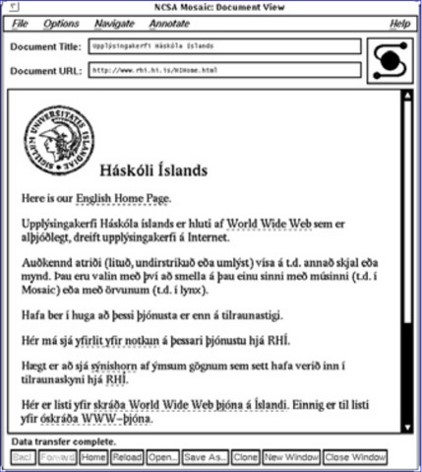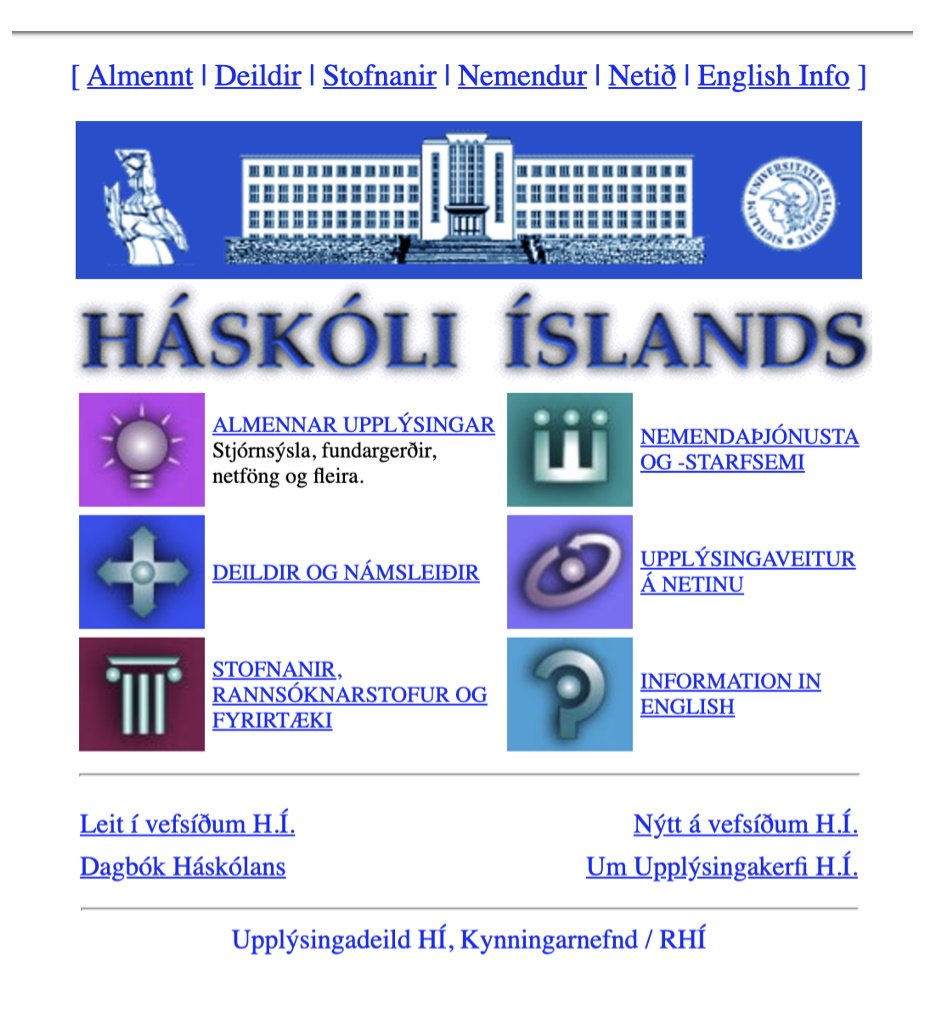These days 30 years have passed since the University of Iceland's website aired for the first time; the first website to open in Iceland as far as we know.
Today the internet is a big part of our lives, whether through our computers, phones, or other gadgets; so much so that many of us feel it has always existed. That is, however, not quite so, as the idea behind computer networks as a means of communication is only about 50 years old, and originates in the US Department of Defence in the sixties.
However, the first internet connection in Iceland came two decades later or around 1986; a European network called EUnet and was brought about by University staff and employees at the Marine Research Institute. These two institutes also had the first .is domains as well as the National Energy Authority, and they are still active today: hafro.is, hi.is and os.is.
The internet as we know it today had not yet emerged and almost no actual websites existed that communicated information online or on the World Wide Web, as it was called in the early days of the internet. It was not until 1989 when the British computer scientist Sir Tim Berners-Lee, often called the father of the World Wide Web, working at CERN in Switzerland at the time, proposed the idea of making information accessible online by using "Hypertext" (HTML) documents. Berners-Lee made his programmes accessible to all so employees at UI Computing Services, currently the University of Iceland Division of Information Technology, could access them and experiment and study the primitive CERN website.
"Then an international communication system called Usenet was used to exchange views on various issues and distribute software. Berners-Lee posted his www-software on this platform, and I downloaded it from there and put it up in November of 1992, and the University of Iceland has had a website ever since," says Magnús Gíslason, head of department at the Division of Information Technology on how first University website and the first one in Iceland came to be.
"As a matter of fact various people had little faith in the website in the beginning and considered it to be the pet project of system managers and that information systems should be built on other networks that actually no longer exist," says Magnús Gíslason, head of department at the Division of Information Technology in the UI Computing Services newsletter from 2002, on the 10th anniversary of the website

Bible search and genealogy
When asked what motivated the UI Computing Services staff in this project Magnús says that another and more imperfect system, Gopher, had been in use to some extent at the time and many wanted to continue with it. "The system managers and a few other employees at UI Computing Services quickly realised that the future would lie in WWW, especially for student management systems at the University," recalls Magnús who went to the first world web convention in CERN 1994 where he met Tim Berners-Lee in person.
This first University website, or information system as it was called, unfortunately no longer exists but according to Magnús it probably only said "Welcome to the University world wide web". "Various information and digital data was then loaded on the website. What I remember best is a search in the Bible and a genealogy database," adds Magnús.
Computers were not as common 30 years ago as they are today but according to Magnús students and staff who had access to a computer could surf the website with a browser called Mosaic." This also applied to everyone connected to the internet, especially staff in research institutes. It was, furthermore, accessible to everyone connected to the internet worldwide. I have to mention the elementary school in Kópasker, a very small town in Iceland, that was a pioneer in information technology in elementary schools and the first networked school," Magnús points out.
The oldest existing version from 1994
The oldest existing version of the University website is from 1994. As you can see here below it is quite different from the page people see today when the open hi.is online. "The University of Iceland's information system is part of the World Wide Web, an internationally distributed information system on the internet," was what those who went online could read 28 years ago.

In the UI Computing Services newsletter from 2002, on the 10th anniversary of the website, Magnús talks about this milestone in a short article where it also says that web measurements, or data gathering on the traffic on the website, had begun in the autumn of 1993 "and according to data from the first whole month of measuring (December 1993) 1,547 pageviews on the webserver and that data was just over 2 MB," To compare the pageviews last November on the University website were almost 400 thousand.
Not everyone believed in the web
In the 2002 newsletter Magnús also talks about how many are surprised to learn that the University website is not older than this, and feel that they have used it much longer. "As a matter of fact various people had little faith in the website in the beginning and considered it to be the pet project of system managers and that information systems should be built on other networks that actually no longer exist," says Magnús in the article.

The University of Iceland website in 1996
The proclaimed "pet project" has indeed grown considerably and prospered during the past 30 years and the website currently serves prospective and current students and staff, university collaborators and the Icelandic public and anyone seeking titbits on hi.is / english.hi.is. The same can be said about the world wide web; it is estimated that it holds over a billion websites that most users now access via their phones instead of desk computers. When asked Magnús says that the rate at which the internet has grown surprised him. "I did not expect that almost everyone would carry around gadgets in their pocket that are connected to the internet, like smartphones are today," he concludes.




